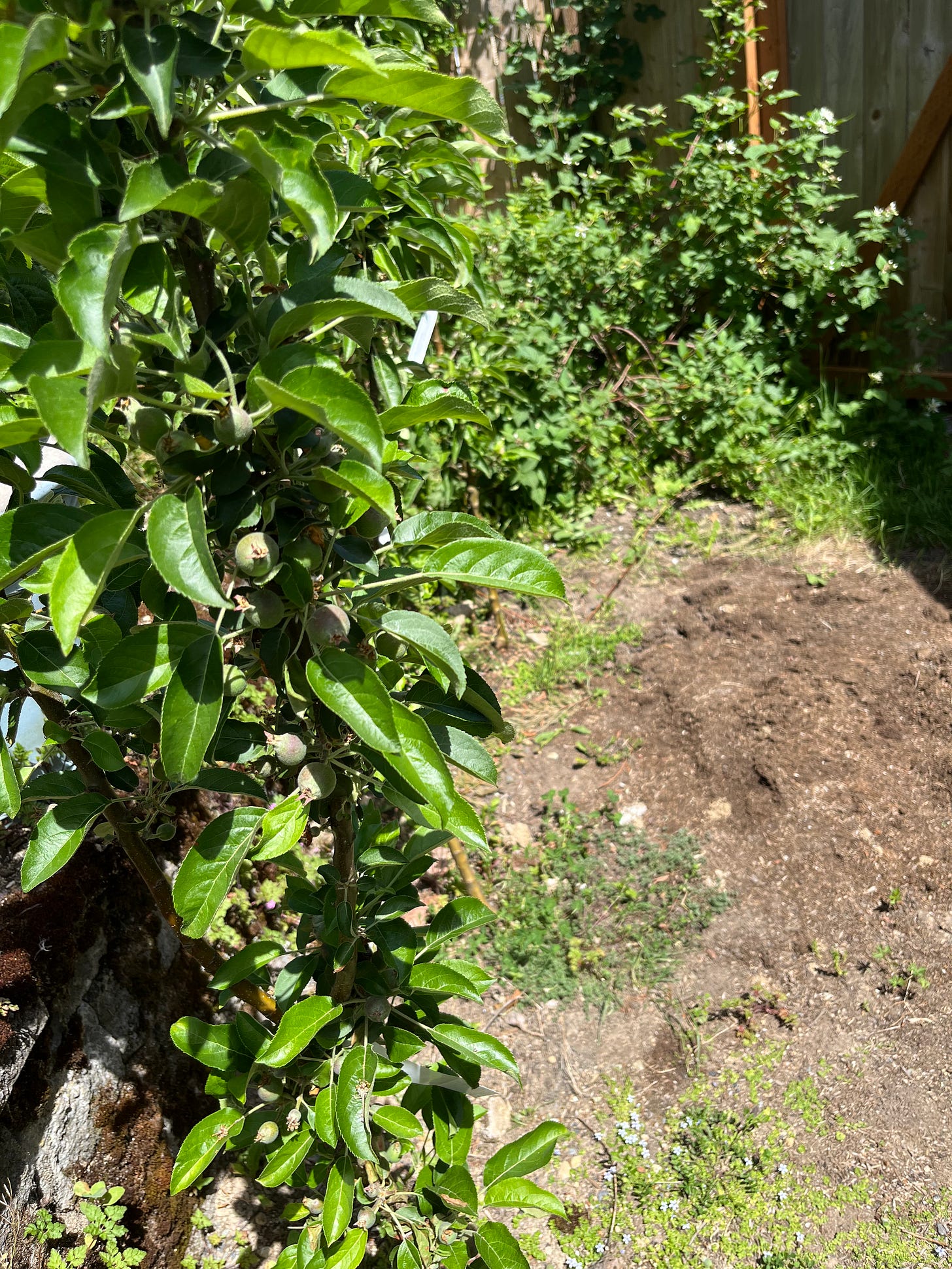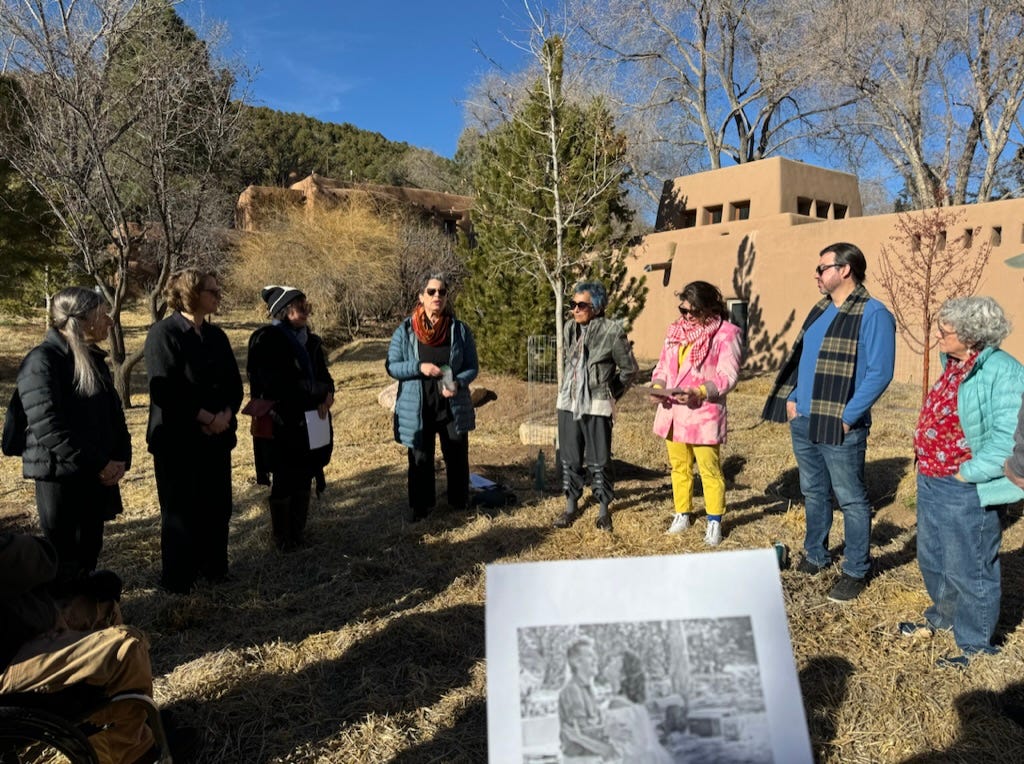The Final Revision of "Planting Seeds in Bobzho's Body"
Soon to be published in the book, Soils Turn, Ecoartspace
“Soul is soil.” Sophie Strand, The Flowering Wand: Rewilding the Sacred Masculine
There’s a little mound of dark brown dirt at the back of my garden. It’s a special pile of dirt because it’s been weeded clean of grass and other vegetation; it seems to be luxuriating in its presence as soil as it waits to be useful in other places. Occasionally, I scoop up several clumps and transfer it to a bed being prepared for seeds or starts, or I transport a container somewhere for ceremony. It was originally a cubic-yard of nutrient-rich soil, but over the past 10 months it has greatly diminished in size as it’s been distributed to many gardens, near and far. As I dug into the pile last week, I was thrilled to discover veins of mycelium running through its rich brown thickness. Somehow seeing this riot of fungal energy made this modest heap a bit holier. Interbeing was and is very visible.
Adjacent to the mound is a line of columnar apple trees in bloom standing like gentle sentries. They were planted in ceremony, less than a year ago. Those trees face the renovated garage that officially became a Zendo in 2022 to house our newly formed sangha, a meditation group in the lineage of Thich Nhat Hanh. The sangha allowed my beloved late partner, Bob, to offer his experience and wisdom to others while traveling on his cancer journey. Bob was a long-time practitioner of Zen, an ordained lay monk, and was trained in several lineages, but he always was careful to say that he was a buddhist with a small “b.” Our sangha also came together to support the healing of our community as we emerged from the trauma of the pandemic. Bob and I had both done several retreats with Thich Nhat Hanh and we had trained with Joanna Macy, so we understood how crucial it was to bring this restorative energy into our community in times of deep trouble.
Some of the members of the sangha came to sit with us because they had collaborated on our community art project, The Tacoma Story Hive. The two of us co-facilitated this pandemic public art project with interested neighbors. I had been building interactive installations for decades, as both a strategy to heal trauma and to connect with others to take actions. Joanna Macy’s “despair and empowerment” work had long been part of my inspiration. Our sculptural hive invited passersby to write or read stories about how people were navigating this time, what challenges they were facing, what skills and resources they were developing, and what their dreams were for the world we could co-create. The hive has been animated for 3 years now. Folks in the community love reading the stories of others as well as leaving their own.
When my late husband and I wrote our wills back in 2015, we researched green burials. We found a “conservation” project near the Columbia River where they planted trees over one’s shrouded body. We agreed that this process would work for us and planned to visit the site. There seemed to be no rush at the time.
Sadly, in April 2023, Bob had arrived at the end of an 18-month cancer journey that had started during the pandemic. While he was in the hospital for emergency care, I learned about a new and legal industry in Washington State: you can now have your body composted. Given that Bob had been a devoted ecological justice activist, working with his organization SEEDS (Social Ecology Education and Demonstration School) on soil remediation projects on Vashon Island, the idea of turning his body into nutrient-rich soil felt deeply in alignment with his life’s purpose. He believed that the carbon sequestration that came from healthy soil was an important way to address part of the climate emergency.
I made plans with the local Earth funeral home before Bob came home for hospice care. On his first day home, I shared with him the possibility of human composting. He looked at me with an expression of dismay on his face, and said, “compost?” I knew then that the cancer had affected his mental capacities, and he was picturing his body becoming a slimy pile. After talking with my death doula friend, she suggested that I frame this discussion by saying that his body would become nutrient-rich soil.
The following day, Bob could no longer speak, and his arms and legs had become paralyzed. The cancer, an aggressive form of melanoma, had likely entered his brain stem, rendering him unable to communicate and move. It was devastating to witness this brilliant mind caught in that realm of muteness and paralysis. While I engaged with his loving gaze, I explained how his body would become nutrient rich soil and trusted that he would bless this decision.
Bob took his last breath at 10 am, April 28th. Members of our sangha had been taking shifts with him so that I could get a little sleep. I told one of them that Bob had left his body and he contacted the sangha and friends to join us.
I was left alone to wash and oil Bob’s body and offer it the gentle tenderness it deserved. I clothed him his brown Vietnamese Zen robe, draped him with the “rakusu” he was given when he was ordained as a lay monk, his prayer beads, and the beaded collar he’d been gifted at a pow-wow several decades earlier. The sangha gathered pink magnolia petals from our blooming backyard tree and adorned him as he lay in state.
Bob’s soil was ready exactly 49 days after his transition to ancestor. My neighbor and I drove to the funeral home in her pickup. A forklift placed the white vinyl bag holding a cubic yard of soil in the truck. When another neighbor’s help, we lifted the bag out of the truck and left it sitting solemnly facing the Zendo and the garden. I was a bit intimidated by its presence at first, but eventually was able to put a gloved hand into what felt like soft loam. After lowering a pail and shovel into the bag, I gathered some of the soil to use in my garden beds. With trowel in hand, I moved gently, hovering over each raised bed, spooning a bit of the sacred soil into each. My path through the garden was an improvisational dance with spirit. I carried saved seeds in a basket, planting them with intention.
In June, seven columnar apple trees were delivered to the garden. Each was planted in some of Bob’s soil as part of his life’s celebration event. The ceremony was full of poetry, ritual, music, and lots of storytelling; the seeds planted by Bob’s life were visibly sprouting in the friends who attended. It gave everyone some joy to connect through our grief.
On the first-year anniversary of Bob’s transition to ancestor, I went on retreat at Breitenbush Hot Springs, a sacred place that has most recently suffered from devastating fires. The community is rebuilding the site with love and care, as are the multiple species of revived organisms clamoring for space on the wounded land. In the company of two lovely friends, we offered some of Bob’s mycelium-rich soil to be part the regeneration. Now, some of his scattered atoms have a beautiful river & mountain view, where they can meditate for all of time.
In the past two years, I’ve done several more ceremonies with Bobzho’s nourishing soil – one at the intentional community, Tamera, in Portugal, as part of their sacred activism program, another at Upaya Zen Center in Santa Fe, New Mexico where Bob did an online training in socially engaged Buddhism during the pandemic. Roshi Joan Halifax who founded Upaya, invited me to choose a tree in their memorial garden where we had a joyous ceremony placing his soil at the base of a newly planted, red oak tree. Roshi Joan also founded the Ojai Foundation many years ago, and the last ceremony was done in Ojai, CA on the sacred land where I did my first in-person retreat with Joanna Macy and later with Thich Nhat. Our son, Sam joined me for that ritual as part of his 30th birthday celebrations. We added one of Bob’s favorite ice cream flavors, coffee, to the soil and placed the mixture at the base of various shrines and trees.
Ceremony at Upaya Zen Center’s memorial tree garden (to my right is the Texan Red Oak tree). Many of the people who joined me that day were studying to be Zen chaplains at Upaya, a few others were old friends (one was a member of our Venice, CA sangha, and another I had known since high school) also some beloved eco-artist peers were there, along with artist/writer members of my cohort at the Santa Fe Art Institute
Planting seeds in our loved ones’ composted bodies may become a more common practice for the ecologically minded. When we do “walking meditation” or solo work in the garden, there’s some comfort knowing that we will all become dirt someday. This embodied version of interbeing very tangibly represents the circle of life that feeds all our descendants.
In “The Work that Reconnects,” a network and way of thinking/being shaped by Joanna Macy and others, there are interactive practices to help people move through this time of “Great Unraveling” and enormous despair, both personal and collective. The movement we get to participate in, if we feel compelled to be part of positive possibilities amid dire circumstances, is called “The Great Turning.” As a participant in that work, I often refer to the teachings of Thich Nhat Hanh. He discusses the process of watering wholesome seeds in our store consciousness and choosing not to water the seeds that might cause more suffering. This year of deep loss, compounded by the multiple horrors taking place globally and very raw scar tissue evident in the collective, has encouraged me to find practices to steady myself and to share those with others. Catastrophizing is a pattern that aggravates suffering. Finding the emotional tools to promote nurturing possibilities, as grief visits us, is crucial in this time. The pain of loss visits all of us, but we can grow from it and plant new seeds, even when heartbreak seems impossible to tolerate.





Bee, I am so happy to 'meet' you on The Emerald Podcast today. Years ago I wrote a piece of music called The Dirt Hums and just last week I joined The Sacred Ecstatics Guild, so humming binds my cells together, so to speak. Our feet tread similar paths. Maybe we'll meet 'in the flesh' one day. Gratitude fills me.
Wowie zowie! This is one of the most powerful essays I've ever read. I almost feel like I know you and Bob now in some sort of intimate way-- you have brought your readers to a very very deep place. Courageous, insightful and oh so loving. Thanks ma'am